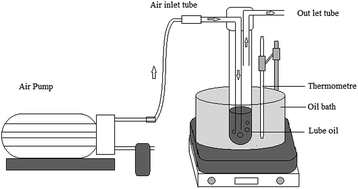Monitoring of oxidation behavior in mineral base oil additized with biomass derived antioxidants using FT-IR spectroscopy
Abstract
This paper reports the artificial oxidation of original and additized mineral base oil (MBO) samples. The additives used were methanolic extracts from rice husk (RHE) and saw dust (SDE). The oxidation was performed at 100 and 200 °C, separately for a time duration of six hours according to the modified IP method. A Fourier Transform Infra Red (FTIR) spectroscopic study was carried out to identify the oxidation products like carboxylic acids/carboxylates, esters, olefins, naphthenes and aromatics in the residual samples. The level of degradation was quantified by measuring the area under carbonyl (C![[double bond, length as m-dash]](https://www.rsc.org/images/entities/char_e001.gif) O) or double bond (C
O) or double bond (C![[double bond, length as m-dash]](https://www.rsc.org/images/entities/char_e001.gif) C) bands in order to determine the concentration of these compounds using Peak Area Increase (PAI) and Peak Height (PH) methods [ASTM 7214-07]. The results indicate that the MBO withstood oxidation in the presence of the RHE as well as the SDE. Among the two antioxidants used, the antioxidant potential of the RHE was more efficient while that of the SDE was better at 100 as well as at 200 °C.
C) bands in order to determine the concentration of these compounds using Peak Area Increase (PAI) and Peak Height (PH) methods [ASTM 7214-07]. The results indicate that the MBO withstood oxidation in the presence of the RHE as well as the SDE. Among the two antioxidants used, the antioxidant potential of the RHE was more efficient while that of the SDE was better at 100 as well as at 200 °C.



 Please wait while we load your content...
Please wait while we load your content...